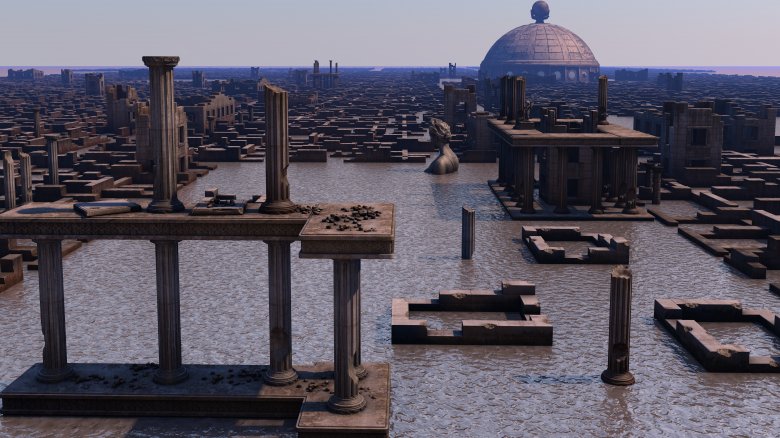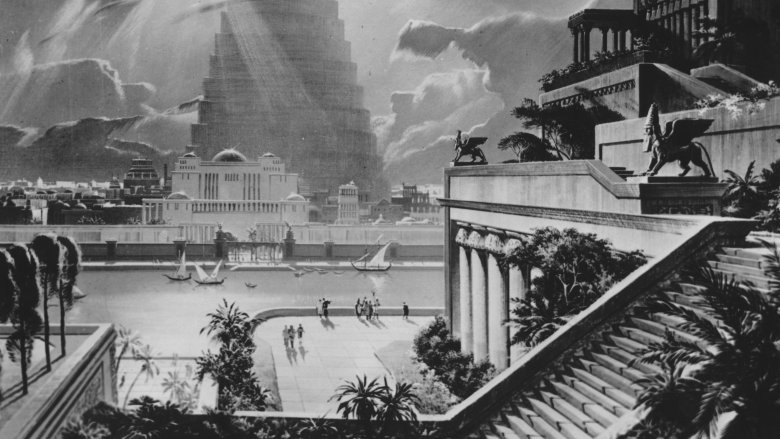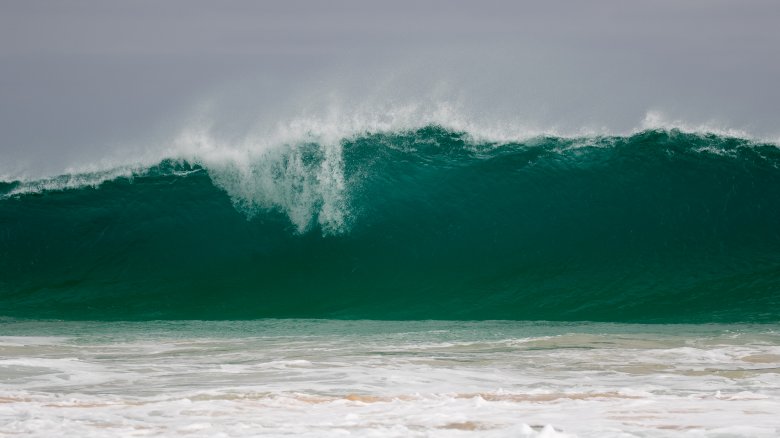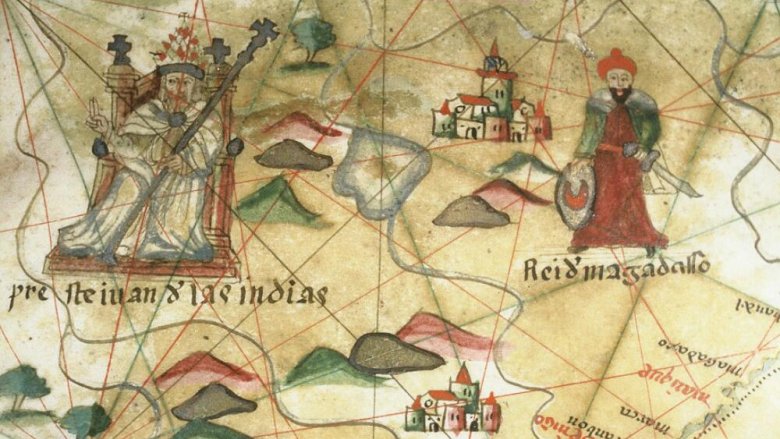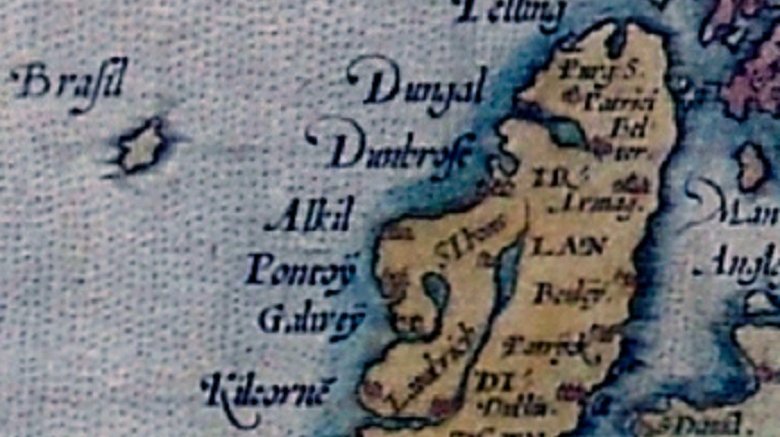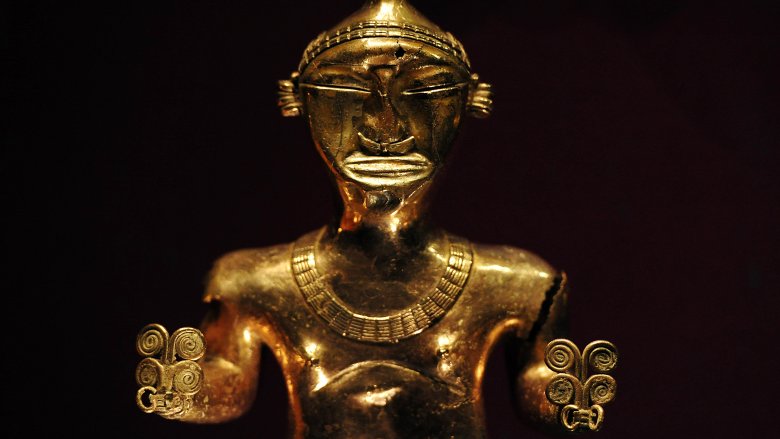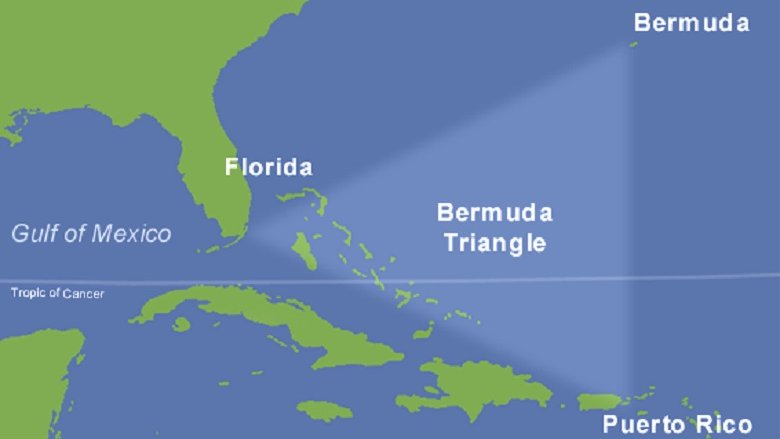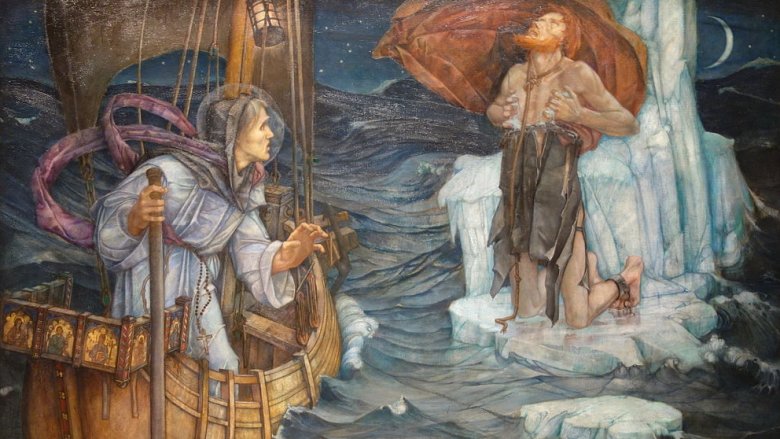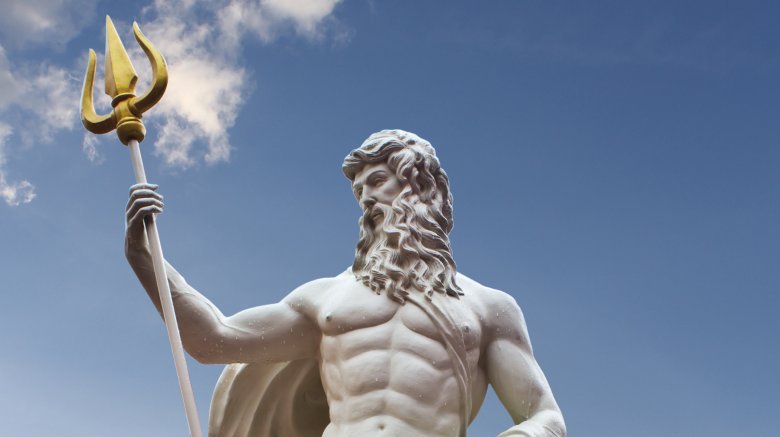Famous Places That May Never Have Existed
You know those days when nothing is going right and you wish you could just escape to a magical land where everything is unicorns and rainbows? Throughout history, people have actually believed in elusive places like these, but they've taken on very different mythologies. Here are some too-good-to-be-true fantasy worlds people really wanted to exist.
The Hanging Gardens of Babylon
When you're king, you can get your wife a seriously nice wedding present. According to History.com, Nebuchadnezzar II supposedly built the Hanging Gardens of Babylon for his homesick wife, Amytis. She was from a place in present-day Iran called Media and missed the lush vegetation found there. The sands of Babylon just weren't cutting it.
So the king built a huge, multilayered garden that came complete with a giant waterfall. In order to grow all the plants and keep them alive, scientists believe it would have taken one heck of an engineering process to get water to all the different stories. The end result was so cool that it made the list of one of Seven Wonders of the Ancient World, right up there with the Giant Pyramid at Giza. Kinda puts your backyard to shame. Maybe try some weeding?
The problem is, the hanging gardens probably never existed. That doesn't mean the ancient world didn't have any sweet gardens, just that archaeological evidence says there was never one in Babylon. We don't even have any first-hand accounts of them, just second-hand ones that would have been written hundreds of years after the gardens were destroyed.
That hasn't stopped people from looking for them. One group of German archaeologists searched for a whole 20 years and has nothing to show for it.
The Kingdom of Saguenay
French explorer Jacques Cartier arrived in what is now Canada in 1534. He was hoping to find a passage to China as well as gold. Instead he met some friendly Indians, and one chief even let him take two of his young sons back to France. In The Forced Removal of American Indians from the Northeast, David Miller says that the boys, possibly as a prank, told him about the Kingdom of Saguenay, supposedly located somewhere in Canada, and filled with as much silver and gold as the Spanish found in South America. Cartier was thrilled and returned in 1535 hoping to find this amazing place.
Instead the boys' father Donnaconna warned Cartier that Saguenay was filled with a race of people who were armed to the teeth. He also told him that while the place was drowning in gold, spices, and oranges, the people there had only one leg, flew like bats, and didn't need to eat so presumably didn't have anuses. You'd think Cartier's joke sensor would have started going off, but all he heard was "gold." So he went looking for the place. He led expeditions until 1542 when the natives finally turned on the settlers and ran them off their land.
The French eventually gave up — the search for the people with no buttholes was over. Canada was great for fishing, less so for shiny stuff.
Lyonesse
About 30 miles off the very southwestern tip of England are the Isles of Scilly. Legend has it that long ago those islands were connected to the mainland by the kingdom of Lyonesse. It, like Atlantis, is now supposedly submerged under the sea. And according to Cornish Guide, its people did something to really piss God off so it was destroyed (like Sodom and Gomorrah), even though we don't know what exactly they did wrong.
Lyonesse was meant to be filled with a bunch of really strong, handsome people. And the residents put their superior strength to good use by building churches. Just, so many churches. There were 140 in total, which seems a bit like overkill for such a small place. But if God got angry at them maybe he'd ask for more, say a nice round 150.
Whatever the reason, one night a storm whipped up a huge wave that swallowed the whole place in one go. But according to legend, one guy made it out alive. He was able to outrun the wave on his horse when he saw it coming. He ran so hard that his horse lost a shoe. These days, numerous families claim to be descended from this last of the hotties, and have a crest with three horseshoes. Another family also makes this claim and has a crest with a white horse. Odd, right? Wouldn't you want a picture of the big strong guy so people don't think you're descended from the animal?
The Kingdom of Prester John
During the Middle Ages, Prester John was Christianity's greatest hope. As Europeans went off on Crusades to fight the infidels in the Middle East, rumors arose that they could be helped by the only Christian kingdom near there, ruled by a man named Prester John. According to Black Past, he was supposedly descended from one of the Magi who visited Jesus and gave him some sweet presents, only now Christian rulers were hoping for gifts of the more jeweled variety. The problem was, no one knew exactly where this God-fearing kingdom was. Theories ranged from the Far East to India to Africa. In the 12th century, Pope Alexander III was so sure of its existence that he sent an envoy to find it. Sadly, the messenger never came back.
But then, suddenly, hope! According to Big Think, in 1165 Emperor Manuel I Comnenus received a letter from Prester John. It outlined just how amazing this kingdom was: it had vampires and people with dogs' heads. It housed the fountain of youth fed by a river from heaven. There were precious gems everywhere and everyone was a perfect Christian, with no theft, lies, or poverty. You know what they say, if something sounds too good to be true...
In the 1400s, Portuguese explorers went to Africa looking to get rich and hoping to find this mythical kingdom. Despite not finding anything, cartographers were still including a vague area for Prester John's realm on maps as late as the 1570s.
Zerzura
It might seem weird to us today with GPS and Google Street View, but it wasn't that long ago when maps had big gaps in them. People weren't able to travel to places that were too cold or too dry. One of those places was the Sahara Desert. No matter how many camels you took with you, crossing the desert was just too dangerous. That might be why a legend grew up that somewhere out there was a mystical city, surrounded by dunes but full of riches, and presumably water, which after days in the hot sun was probably worth more than gold.
Called Zerzura, it was surrounded by beautiful white walls and had a large gate with a bird on it. Tired travelers could open the gate using a key in the bird's mouth and enter this amazing city. The author Harold Scot says even though the legend is from at least the 1400s, explorers were still looking for this lost oasis in the 1930s. By then they had ditched the camels and were using cars, which kind of takes away from the mysteriousness of it all.
Finally, one expedition found three lush valleys, called wadis, that were supposed to surround the city. But they found absolutely no evidence of walls or riches anywhere. It's possible that the wadis were so helpful to old school caravans that the idea of a town just sprung up organically until the legend stuck.
Hy-Brazil
The island of Hy-Brazil showed up on a map in 1325 and stuck around for 500 years. Located somewhere off the coast of Ireland, according to Stephanie Cyr, assistant curator in the Norman B. Leventhal Map Center at the Boston Public Library, it was one of a few legendary islands that showed up on maps at that time. It was supposedly perfectly round with a river running straight through the middle.
The island was originally thought to be visible only once every seven years due to the heavy fogs that surrounded it. (It's similar to the modern-day mythical land of San Francisco.) But if you could get to it, legend said you would find giant black rabbits, a sorcerer, actual gods, some lost civilizations that were possibly immortal, and even UFOs. It's surprising they didn't throw in the Holy Grail. According to Ancient-Origins, at least two expeditions set out from Bristol, England, to try and find it, with no luck despite spending months at sea.
In 1674, Captain John Nisbet supposedly found the island after getting lost in a fog, according to Irish Central. Four of the crew went ashore and spent a day there, returning with bunches of silver and gold that an old man gave them, because people do stuff like that in real life and not scurvy-induced delirium. The tiny round island was included on maps until at least 1768, but by then the cartographer had the logic to label it "imaginary."
Thule
Not many people have heard of it today, but at one point the legendary land of Thule was as infamous as Atlantis. According to Humanities and Social Sciences Online, it was supposedly discovered in the fourth century B.C. by a Greek explorer named Pytheas. He returned with amazing stories of a frozen land where it was always dark, yet people still lived there. Obviously, today we know places like this actually exist above the Arctic Circle, but to his contemporaries hanging out down by the warm and sunny Mediterranean, this must have seemed insane.
Still, other adventurers decided they had to see this amazing land. The Romans made it all the way to the Shetland Islands that lie just north of Scotland and assumed they had found Thule. The Victorian Richard Francis Burton went to Iceland and was sure that was actually Thule. Then there were the Nazis.
Yeah, one of these things is not like the other. Times Higher Education explains that the Nazis were pretty obsessed with Thule. After World War I, a Thule Society formed. It counted as members Rudolf Hess and Adolf Hitler himself. But it wasn't just a "wow, Thule sounds like a cool place" club. It took the idea of this icy land and twisted it to white nationalism. For them, Thule was the place the ideal white race came from. Leave it to the Nazis to take a nice fairy story and make it gross.
El Dorado
When Europeans stumbled on the New World, they went a bit gold crazy. Really, what was the point of exploring this new land and killing most of the inhabitants if they weren't going to be able to Scrooge McDuck into piles of gold? So they were only too ready to believe that somewhere in South America was a city made of gold with untold riches.
National Geographic says the rumor started when they heard about a ceremony performed by one tribe when a new chief came to power. He would cover himself in gold dust and throw treasure into a lake to appease the gods. This man became known as "El Dorado." The Spanish managed to find the lake and drained it enough to collect some gold, but it wasn't enough. They knew there must be a city out there.
Looking for El Dorado became a dangerous obsession for some. English explorer Sir Walter Raleigh went looking for the mythical city twice, and his son was killed fighting the Spanish while looking for it the second time. Raleigh blamed another member of the expedition for letting his son die, so the man killed himself. When Raleigh got back to Britain, the king ordered him to be executed because he had ignored his orders not to mess with the Spanish.
These days we've stopped looking for it and instead write songs and movies about the mythical city.
Shangri-La
In 1933, writer James Hilton Introduced the world to Shangri-La. He wrote a novel called Lost Horizon, which took place at a monastery full of Buddhist lamas in Tibet. They lived in a valley that, despite being totally cut off from the rest of the world, had somehow managed to store all human wisdom and lots of less ethereal treasures. According to the BBC, the book was incredibly popular, to the point that people even started calling Camp David "Shangri-La."
But the legend of Shangri-La is actually ancient. PBS says it originated in India in 962 A.D. and went on to become a Tibetan myth. (They called it Shambala.) This city was supposed to be located in the Himalayas on a high plateau underneath a mountain made of white crystal. There was a lake and a palace, but it could only be visited if you made it over a ring of peaks. It was populated by people who lived perfect Buddhist lives in harmony with each other. Obviously, any contact with our messed-up world would scar them for life, so they're waiting for the day we manage to solve world peace before showing themselves.
The myth is so popular that even the current Dalai Lama has talked about it, although he thinks it's more a mental journey to a perfect imaginary place than a real location. After all, when you're looking for Shangri-La, aren't you really just looking for yourself, man?
Bermuda Triangle
The legend of the dangerous Bermuda Triangle hasn't been around that long. Live Science tells us the name was coined in 1964 by a writer named Vincent Gaddis. It didn't come into popular use until even later, but once it did, the idea that flying or sailing over a small part of the Atlantic Ocean equaled imminent danger was huge. The first book about it came out in 1974 and was a bestseller. Since then thousands more people have cashed in on the Bermuda Triangle.
There are plenty of theories about what causes all these mysterious disappearances of ships and planes in the area. Some think that the Triangle is located over the lost city of Atlantis, and that it sends out "crystal energies" to disrupt travel. Or people say it could be a rift in space-time that's pulling people in. And when in doubt, blame aliens. Some of the less crazy ideas include pockets of methane exploding and rogue tidal waves. No matter what, people know that something is happening in there.
Or is it? What if the Bermuda Triangle didn't even really exist? The problem with legends like this is it's hard to check your facts. So when someone says an inordinate amount of ships and planes disappear in this area, other people just accept it. But really, not that many go missing. The ones that do often "disappear" in bad storms, making what happened to them a lot less mysterious.
The Island of St. Brendan
St. Brendan got around. No boring life in a monastery for him; he traveled so much that he got the nickname "the Navigator" and was made the patron saint of sailors. Born in Ireland in 484 A.D., St. Brendan spent his life moving around and converting people. But according to History.com, one of his voyages has become legendary.
When another monk told St. Brendan that Paradise existed somewhere beyond the horizon, the saint decided he had to go see it for himself. Of course, he didn't make this decision lightly. First he fasted for 40 days, staring out at the sea, because all good decisions are made when you're super hungry.
According to the legend, he built himself a boat, despite being in his 80s, and got a crew of anywhere from 18 to 150 people. Then they set off and immediately started seeing crazy things. There were crystal pillars just floating on the ocean, sheep that were the size of cows, and talking birds that knew the psalms. It wasn't all smooth sailing. They also ran into giants who threw balls of flames at the ship. But they finally made it, landing on a place they thought was the Garden of Eden, which was full of plants, lots of delicious fruit, and colorful stones. They stayed for 40 days, until an angel appeared and told them to get lost. Then he went home and told everyone about the crazy trip.
Atlantis
Atlantis was the OG lost land, and its legend appeared thousands of years ago. Plato was the first person to mention the missing island in 330 B.C., but his description might sound a little different than the myths you've heard. According to archaeology professor Ken Feder, the ancient philosopher said Atlantis was ahead of the game when it came to technology, but they were "morally bankrupt" and used their power for evil, trying to take over the world. Fortunately, a ragtag group of ancient Athenians were able to defeat the Atlanteans, despite being heavily outnumbered. The whole point of the story was to talk about how great Athens was, not to get people fixated on this mysterious island.
And that worked for a couple thousand years, until 1881, when Ignatius Donnelly said, "Wait a minute, that technologically advanced country sounds pretty cool." He started the conspiracy theories, saying that ideas like metallurgy, agriculture, religion, and even language must have originally come from Atlantis. Other people took the baton and ran with it, and the idea of Atlantis as a mystical utopia emerged.
People have looked for Atlantis for decades, with dozens of possible sites being put forward, despite Plato being very clear that it was in the Atlantic Ocean. But it doesn't matter where he said it was, because Plato totally made Atlantis up. So if you want to explore the ocean floor, you'll be looking for a long time.
